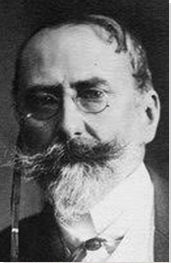Summary of William Merritt Chase
Chase was a multitalented artist; a man prepared (and able) to explore modern and traditional stylistic ideas via city landscapes, studio interiors, society portraiture and still lifes. He proves to be an intuitive observer of his time and place, taking up his palette to capture impressions of New York leisure pursuits at the turn of the nineteenth century. His city park scenes were rendered through loose brushwork and a light palette that brought the influence of French Impressionism to the New York art scene. He gained recognition, too, for exploring Impressionistic techniques through a revival in pastel compositions. Meanwhile, his portraiture, and especially a series of remarkable late-career still lifes, saw him draw much more on the sombre tonalities he took from his academic training in Munich. In addition to his own artistic output, Chase carved out a career as one of America's most esteemed art teachers that would see him tutor several future American greats including Edward Hopper, Georgia O'Keeffe, Charles Sheeler, and Rockwell Kent.
Accomplishments
- Chase was a key figure in introducing French Impressionism to the American public on two fronts. Firstly, he used Impressionist techniques to paint the leisure activities of middle-class families who congregated in the newly designed parks of Brooklyn and Manhattan. Secondly, he was instrumental in bringing the Impressionist paintings of Claude Manet to New York galleries for the first time.
- Inspired by the great studios he had visited on his tours of Europe, Chase transformed his New York atelier into a magnificent artist's retreat that allowed New York to rival Paris and other European locations as a world centre for artistic sophistication. An obsessive collector, his studio was a veritable Aladdin's Cave of objet d'art and bric-a-brac that doubled as a social space where New York's artistic community came to socialize and to be "seen". His studio confirmed Chase's own standing as a well-travelled, urbane, society figure and it became the subject of a number of his early works.
- Chase was an accomplished portraitist, producing paintings of family members, society figures, and professional acquaintances such as James McNeill Whistler, whose sparse aesthetic Aesthetic style often informed his own treatments. But Chase has drawn special praise for his portraits of women whom he presented in a variety - active and meditative; familial and professional - of roles. He also painted several female students whom he welcomed and supported at a time when it was seen as improper for male artists to encourage women to pursue careers as artists.
- His vital contribution to the birth of American Impressionism has sometimes overshadowed Chase's commitment to realism. His exhaustive collection of objects and ornaments provided a good deal of still life source material for Chase and his students, but it was his late-career fish paintings that are considered modern American masterpieces. His fish series abandoned his impressionistic palette in favor of a rich academy technique that took the best from the likes of Rembrandt, Velázquez, and Leibl.
- Chase was a member of the so-called Ten American Painters group. The group was invested in the international phenomenon of Eclecticism (sometimes referred to as Cosmopolitan Eclecticism); that being the belief that innovation in art was achieved through an openness to experimentation through the blending of existing styles and genres. Such was the influence of Chase's painted studio interiors, that revelled in his vast and eclectic displays of European and Asian objects and artifacts, Chase has also been singled out as the founder of one of the most significant aspects of turn of the century American art, namely the artful interior.
The Life of William Merritt Chase
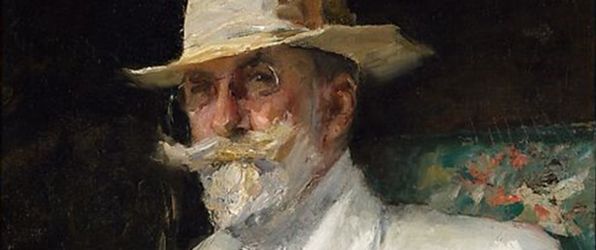
"Take the best from everything", Chase instructed his students, "I have been a thief, I have stolen all my life", but I have "never been so foolish and foolhardy to as to restrain for fear I should be considered not 'original'".
Important Art by William Merritt Chase
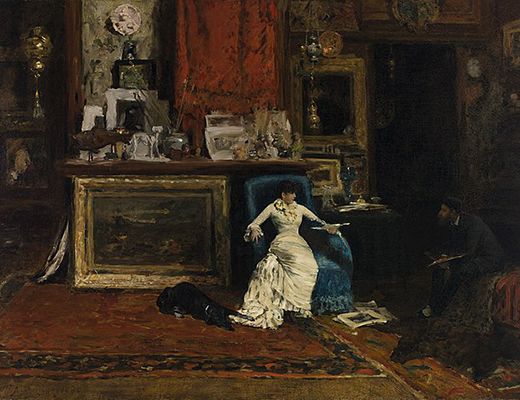
The Tenth Street Studio
A plush studio is the setting for Chase's painting. It is filled with many golden framed pictures and luxurious objects including imported porcelains, a lamp (hanging from the ceiling), a large gold vase (on a shelf), and a large Oriental carpet. Just right of center, a female model in an elegant white dress sits in a vibrantly blue colored chair while the artist sits to the sitter's left sketching and his large black dog sleeps on the carpet.
When Chase arrived back in America after completing his first European tour, he settled in New York City and quickly set about finding a studio that would fulfil his wish of occupying "the finest studio in New York." He settled on a space in the Tenth Street Studio Building and went about decorating it with the collectibles he had amassed while in Europe.
Chase's studio was his haven but it was also a place for friends to gather and to "mingle". Chase was so inspired by his studio that he painted it several times during the 1880s. According to curator, Erica Hirshler, "Chase's rooms, which echoed the great studios he had seen and admired in Europe, enhanced his reputation as a well-traveled, dapper, creative practitioner of the arts. Often wearing a fez and accompanied by one of his pet wolfhounds, Chase presented himself against a backdrop of hundreds of objects from around the world: old master paintings, Japanese parasols, Renaissance furniture, Islamic lamps, fabrics, rustling chimes, great copper pots, and dozens of exotic shoes". The idea that artist and patron were sophisticated enough to appreciate such tasteful surroundings was a significant marker of social standing in late nineteenth century New York.
Oil on canvas - Collection of Saint Louis Art Museum, Saint Louis, Missouri
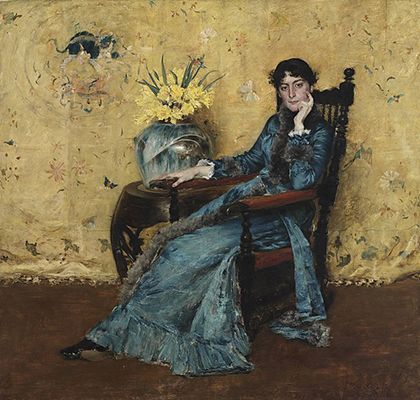
Portrait of Dora Wheeler
Dora Wheeler adopts a reflective look as she reclines into a tall backed chair with red seat and arm rest cushions. Wearing a blue dress, trimmed in fur, she rests her chin in her left hand while next to her is a table on which rests a large blue and white vase filled with yellow flowers. According to Hirshler, the artist, "made his name by picturing women [captured] in a variety of roles, both active and meditative, in public and at home, and in professional and domestic guises".
Some of his female sitters were his students who went on to become established names on their own terms. As The Cleveland Museum of Art explains on its website, a young "Wheeler became Chase's first student when he returned from overseas study in Munich and set up a teaching studio in New York. At the time, few American artists accepted women as private pupils. After her course of study, Wheeler joined her mother in launching a successful decorating firm, one of the first businesses in the country to be operated entirely by women. For the firm, she designed luxurious textiles, and the embroidered silk tapestry that fills the background in her portrait references her occupational interest".
Oil on canvas - Collection of The Cleveland Museum of Art, Cleveland, Ohio
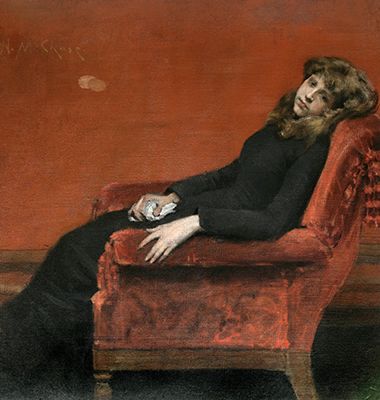
The Young Orphan
It is the gaze of the young woman resting in a red velvet chair that first grabs the attention in Chase's painting. Wearing a long black dress, she rests her head against the back of the chair and looks out absently at the viewer. Set against a red wall, in the same shade as the chair, the only other burst of color comes from the white tissue the young orphan clutches in her right hand.
While Chase was known for his portraits of society women, this is one in which the sitter is steeped in some mystery. As Hirshler points out, "if she is identified as an orphan, she seems plainly in mourning, her black dress and clutched handkerchief indicative of her grief". However, Chase first debuted the work with the title At Her Ease and if we consider the work under that heading then, as Hirshler argues, "her heavy burden is lifted, allowing a more positive interpretation of her daydreams". Given that the theme of women in contemplation was a topic Chase often explored, it is not clear why he chose to change the title, but when he did so, it allowed for a wholly different interpretation of the subject.
James McNeill Whistler's influence is in strong evidence in this painting. The over the shoulder gaze of the woman is very Whistleresque while Hirshler picked up especially on "the famous example that inspired the costume, composition, and thinly applied pigment" that marked Whistler's most famous 1871 portrait of his mother (Arrangement in Black and Grey, No. 1).
Oil on canvas - Collection of National Academy of Design, New York
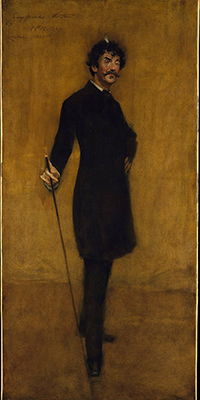
James McNeill Whistler
Chase became aware of Whistler while studying in Munich and would have become closely acquainted with his most famous portrait, Arrangement in Grey and Black, No. 1: Portrait of the Artist's Mother (1871), when it exhibited in 1881 at the Pennsylvania Academy of the Fine Arts in Philadelphia and, in 1882, at the Society of American Artists in New York. Three years later Chase met Whistler in London. Despite Whistler's reputation as a "difficult" man, the two got along famously (initially) and Whistler persuaded his compatriot to extend his stay in England so they might paint one another's portrait. (It is also likely that the two men discussed urban scenes given Chase's imminent excursions into that genre and the fact that Whistler had only recently sketched and painted several London park scenes himself.)
Chase depicts Whistler as a tall, slim, figure bedecked in formal black attire. Whistler looks out at the viewer, his head turned slightly to the right, his left hand resting on his hip, while his right hand holds a long, thin walking cane. While Chase enjoyed painting Whistler, he had a more difficult time as Whistler's sitter and complained in a letter home that "[Whistler] proved to be a veritable tyrant, painting every day on into the twilight, while my limbs ached with weariness and my head swam dizzily".
The style in which Chase depicted Whistler evokes both his subject's own personality and Whistler's influence on Chase. According to Hirshler, "Chase's likeness of his fellow American artist emulated Whistler's spare, self-consciously aesthetic style" and can be seen in some ways as a tribute to the man himself, especially in the way "Chase captured Whistler's theatrical persona in the role of an artist, a dramatic character that Whistler himself cultivated". Whistler, however, did not like the rendering at all and, according to Hirshler, he "called Chase's painting a 'monstrous lampoon' and complained about Chase for the rest of his life". Whistler's portrait of Chase has not survived and many believe that Whistler destroyed it as an act of spiteful retaliation against Chase.
Oil on canvas - Collection of The Metropolitan Museum of Art, New York
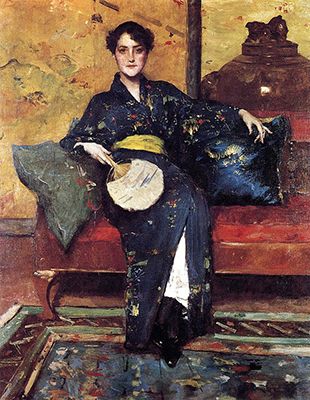
A Comfortable Corner
A dark-haired woman, wearing a blue kimono and yellow sash is seated on a red couch. She is staring out at the viewer, her left arm is draped on a blue pillow as she holds a white fan in her right hand. While the allure of all things Oriental was strong in many artists of the period, Chase's love for Japanese culture was so strong, he not only collected many items from the country, but also named one of his daughters Koto after one of his favorite Japanese students.
Chase painted a series of portraits featuring women wearing kimonos. Often these paintings included depictions of the Japanese objects he had on display in his studio. This painting, as Hirshler explains, demonstrates, "Chase's interest in Japanese art in the context of his penchant for accumulating an eclectic array of beautiful things, while also revealing at least some understanding of Asian compositional devices". Yet the work is still Western in many ways. According to Hirshler, the model's "legs are demurely crossed at the ankle, but the robe allows a glimpse of her polished leather shoes, black silk stockings, and white ruffled petticoat, reinforcing common sensual associations of women, silk textiles, and Asia. Once again, Chase uses the edges and borders of the rug, sofa, and screen to provide an underlying geometrical structure to his composition [...] although the solidity of Chase's forms and the animation of his brushwork prevent this composition from looking anything but Western".
Oil on canvas - Collection of Parrish Art Museum, Water Mill, New York
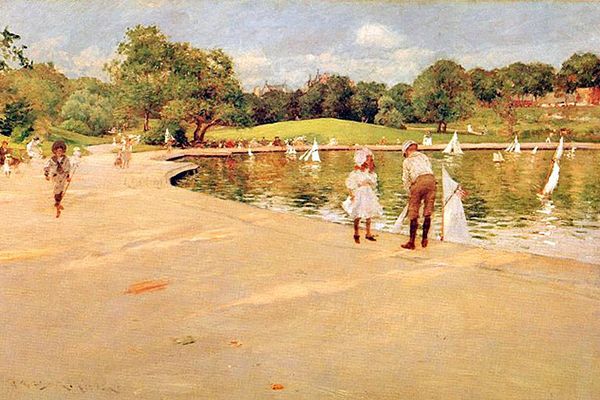
Lilliputian Boat-Lake - Central Park
Chase would have seen many urban subjects painted in impressionistic styles in New York in April 1886, when the Parisian art dealer Paul Durand-Ruel curated an exhibition of some 300 paintings by the likes of Manet, Degas, Pissarro, Monet and Caillebotte. Chase realized that city park scenes offered the perfect setting for impressionistic vignettes; especially so Prospect Park and Central Park which were associated with genteel, petit-bourgeois recreation. The Hirshler observed that Chase often "record[ed] the games and pastimes of youngsters whose families could afford their leisure". In this painting, a young boy and girl prepare to launch their fine toy yacht into a manmade boating lake. The lake is crowded with similar vessels, while other children are seen at the water's edge in various acts of play.
Chase painted several images in New York's Central Park. In choosing such a location he emulated the great French artists who made the theme of Parisian leisure time a key tenet of the Impressionist movement. Indeed, Chase's scene is impressionistic in style; rendered as it is in loose brushstrokes and the plein air approach that captured the variable effects of natural light on canvas. Chase's was a distinctly American setting, of course, and the newly created and modern Central Park (opened to the public for the first time in 1858) saw the Americanization of Impressionism and a more contemporary approach to landscape painting in his country.
Oil on canvas - Private Collection
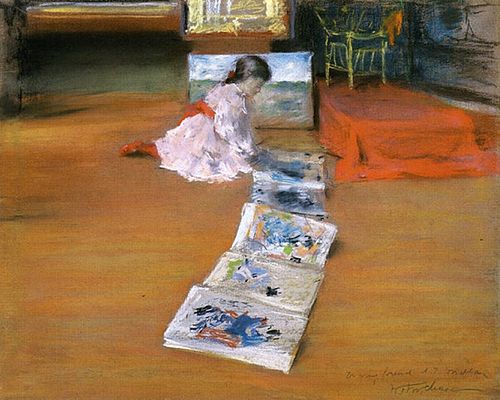
Shinnecock: Studio Interior
A young formally dressed child wearing a pink dress with a vivid red bow tied at her waist and red shoes is depicted sitting on her knees on the floor of a studio. Behind her are a number of paintings in various stages of completion; but it is the large book spread out on the floor in five distinct pages that becomes the focal point of the canvas.
Chase's love of Japanese culture is again in evidence here, although displayed in a rather more subtle way than through his earlier series of portraits depicting women dressed in kimonos. Here, his eldest daughter Alice/Cosy (who he had painted four years earlier dressed in a kimono) is pictured looking at a book of Japanese prints on the floor of her father's studio in Shinnecock Hills, Long Island. As Hirshler observed, in painting these works "he capitalized on popular taste [...] but he also intended to pay homage to the art he deeply admired. Cosy came to share his enthusiasm".
More than its thematic interests, perhaps, this work provides a fine example of Chase's skill in the medium of pastels. The Phillips Collection website describes how, "throughout his career, Chase experimented with pastel alongside his work in oil, translating the painterly qualities of wet color to the velvety effects of dry pigment". Here specifically the medium of pastel is used to render a beautifully realized Impressionistic work.
Pastel on paper mounted on canvas - Collection of Terra Foundation for American Art, Chicago, Illinois
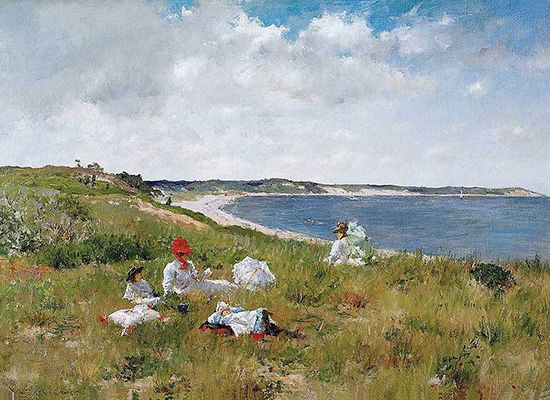
Idle Hours
The title of this painting perfectly sums up the theme depicted. Two women and two young girls are seated relaxing in the grass while in the background we can see a stretch of beach bordering a tranquil blue ocean. This painting provides an example of how Chase used his family as subjects: his wife, Alice, two of his daughters, and his sister-in-law. As Hirshler describes it, "Alice reads while one of the girls gazes up at the shifting clouds, her abandoned berry bucket adding a note of bright red to match her mother's hat and the decorative trim of the plump cushions".
From 1891 Chase spent the summers at his family home in Shinnecock Hills. The home doubled as a summer school where he tutored aspiring artists. Just as Claude Monet drew inspiration from the beautiful surrounding of his gardens in Giverny, so Shinnecock Hills inspired Chase to create some of the best of his landscape paintings. The loose brushstroke style evident here became characteristic of the American Impressionist style of which Chase was a champion. His mastery over the brush is evident here; a point made clear by the author Katherine Metcalf Roof who stated, "Chase always drew with the brush. It was the way natural to him and the method he believed in as the best means to the end. He [even] encouraged his students to paint almost as soon as they drew".
Oil on canvas - Collection of Amon Carter Museum of American Art, Fort Worth, Texas
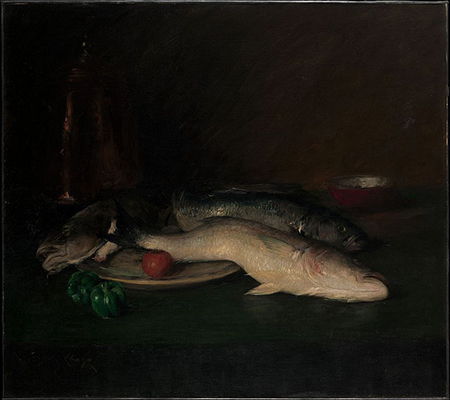
Still Life: Fish
The focal point of this still life are the three fish draped over a plate. Their heads are resting on the tabletop in an unconventional composition that includes two fish on the right side of the canvas and one, partially obscured fish, to the left of the plate. In a predominantly dark and shadowy work, the only color coming from the underbelly of the central fish, the green of two small bell peppers, and the red of the tomato and the bowl. As Bettis put it, "In his later years his still-life oeuvre was enhanced by an extraordinary series of fish studies, in which the artist's virtuoso brush transforms the pink and white luminosity of the recumbent fish to an object of almost abstract beauty', adding that Chase "often executed such studies in three or four hours".
Chase once offered the maxims, "while there is still life there is hope" and "do not try to paint the grandiose thing. Paint the commonplace so that it will be distinguished". According to The Metropolitan Museum of Art, "Chase made many large-scale still-life paintings of fish, usually during his summer teaching trips to Europe. Executed with the bravura brushwork and dark palette of his early Munich period this painting shows the influence of Chase's contemporary, the French artist Antoine Vollon, and of the seventeenth-century Spanish still lifes that Vollon also appreciated".
Chase was interested in what his legacy would be and, as Roof describes, when touring an exhibition with fellow artist Birge Harrison and his wife, Harrison complimented Chase's fish painting calling it a "masterpiece" to which he responded, "Yes, yes, I suppose that some day I shall be known only as a painter of fish". Harrison was not alone in his praise, and according to The Metropolitan Museum of Art, "writing in 'The New Republic' in March 1917, the American connoisseur and collector Leo Stein commented [...] 'Of all non-sentimental still life [...] they are with their bulging mass and sweeping line the most expressive".
Oil on canvas - Collection of The Metropolitan Museum of Art, New York
Biography of William Merritt Chase
Childhood and Education
The eldest of six children, William Merritt Chase was born to Sarah Swaim and David Hester Chase. He demonstrated an aptitude for art from an early age by copying images from his favorite books. According to author Katharine Metcalf Roof, Chase's "interest in art made him different from his classmates, many of whom teased him and of which he later stated, 'I am not sure that it is a bad thing to go to school, as I did, where the boys threw things at me, and asked if there was nothing else I could do'". She added that William did impress his younger brother George who remembered that "'he had only to make a few marks and the thing was done'".
Having relocated from Williamsburg to Indianapolis when he was still just twelve years old, William was exposed to other artistic activities including the theater. As Roof explains, "the moral code of the Chase family forbade cards, dancing, and the theatre; but in wicked Indianapolis William permitted himself to be led astray". Indeed, on prompting from a friend, he took a minor role in a local play. Roof notes that he enjoyed the experience so much that "for a time he was held by the lure of the footlights, then the fear of discovery conquered, and he gave up his double life".
Chase's father was a strict man who initially struggled to come to terms with his son's artistic ambitions and when he was fifteen he forced his son to work in the shoe store he managed. His father quickly learned that his teenage son had no interest in a career in sales. As Roof describes it, William spent the bulk of his time "drawing on the wrapping paper [and he] was likely to slip out of the shop at the most crowded hour to look at works of art displayed in a neighboring shop-window".
Early Training
At the age of nineteen, Chase succumbed to youthful wanderlust and, on a whim, decided he wanted to become a sailor. With his father's blessing, he and a friend traveled to Annapolis where he was commissioned to a merchant ship. Not long into his a three-month voyage, Chase realized that the nautical life was not for him; a realization aided by the cruel teasing he suffered at the hands of fellow sailors. When he learned of William's woes, David Chase arranged for his son to be returned home where he once more took up employment in his father's shoe business. Unable to deter him from his interest in pursuing a career in art, his father enrolled him with a local art teacher, Benjamin Hayes. It was Hayes who eventually convinced Chase's parents of their son's talents and they duly agreed to send him to New York City where he commenced his studies in earnest.
A twenty-year-old Chase arrived in New York in 1869 where he studied at the J.O. Eaton studios and the National Academy of Design. He exhibited works in New York before re-joining his family in St. Louis, Missouri (the Chase's having recently relocated there from Indianapolis) in 1871. After about a year in St. Louis, four of the city's leading businessmen provided Chase with the funds to travel and study in Europe in exchange for a pledge that he paint their individual portraits in the future.
Most Europe-bound American artists were drawn to Paris but Chase opted instead for Germany where he enrolled at the Munich Royal Academy. According to curator Erica Hirshler, the Academy was "a rigorous art school [where Chase] developed a rich, dark, sculptural painting style and a lifelong love for the works of the old masters". His tastes were eclectic, but he was drawn to the works Rembrandt, Peter Paul Rubens, Frans Hals, and Diego Velázquez, and especially the more flamboyant chiaroscuro styling of the German, Wilhelm Leibl. In Munich Chase made lifelong friendships with fellow students Frank Duveneck and Walter Shirlaw and, though he was a serious, studious, individual, he was not above high spirited pranks. Roof retells an anecdote in which a fellow student bet Chase he could not paint an object so convincingly it might be mistaken for the real thing. Chase won the challenge when his professor attempted to hang his hat on his painted wall peg.
On completion of his studies, Chase settled for a period in Italy. It was in Venice that he began his lifelong passion for collecting miscellaneous objects ranging from knick-knacks, to picture frames, to old items of furniture, and paintings. He developed a particular fondness for clocks and rings; often wearing the latter himself. Once established as a painter and teacher, his studios would be filled with collectibles, many of which would serve him and his students with objects for still lifes. While in Venice, Chase saved a monkey named Jocko from being abused by some sailors and adopted him as a pet. It was the beginnings of a lifelong love of animals, and he bought a second monkey, Jim, and had both primates live with him at his Venice studio. He was grief-stricken at the passing of Jocko, and when he decided to return to America, he arranged for Jim to be taken in by an Italian friend.
Mature Period
By the time Chase returned home in 1878, he had already begun, in the words of Hirshler, to "build his American reputation by sending paintings from Munich to New York City for display". Once settled again in New York, he took his first teaching positions at the newly formed Art Student League.
Chase felt it vitally important to his reputation that he work in superlative surroundings and thus rented a space in the Tenth Street Studio Building. Designed by Richard Morris Hunt, and opened in 1856, Tenth Street (a site previously occupied by members of the Hudson River School) was the first building in New York to be (re)designed specifically for artists' use and its presence in the city signified a growing professionalism in American art (and New York as the American art world's epicentre). Having taken over a large gallery space intended originally for exhibitions, Chase, according to Kirshler, "created a studio environment that reflected his eclectic tastes and his belief in the transformational power of art. Modeled on European precedents, his rooms became a temple to art and a destination for aesthetic pilgrims". The artist's biographer Emery Battis added, "Brimming with self-confidence [...] Chase acquired the vast salon space in which Albert Bierstadt had executed his monumental western landscapes. At great expense, Chase converted the studio into an exotic showplace, which became a social center for the local artistic fraternity; the gesture enhanced his reputation as a genteel Bohemian and also attracted numerous prestigious and remunerative portrait commissions".
Adding to the attraction of Chase's studio was his extravagant display of collectibles, his English and Russian hound dogs, his two macaws and a cockatoo. In fact there was an aura about Chase which was enhanced by his Dandyish dress code. As Roof explains, he stood out from the crowd through his "[neatly groomed] hair and beard, immaculate linen, white spats, black-ribboned glasses, rings, garments of the latest fashion [and his] custom of wearing a scarf-ring [and] a large carved emerald set with small diamonds [which] was his favorite".
Already an established artist, Chase made a reputation for himself as a teacher too. With his unusual still lifes (based on many of his collectibles) and his habit of bringing his dogs into the classroom, he was extremely popular with his students. Of his teaching career he recalled fondly, "I believe I am the father of more art children than any other teacher [while my close] association with my pupils has kept me young in my work. Criticism of their work has kept my own point of view clear". In the course of his teaching career, Chase would tutor some of America's greatest modern artists including George Bellows, Marsden Hartley, Edward Hopper, and Georgia O'Keeffe (who, according to director Dorothy Kosinski, "called her teacher fierce"). Sadly, Chase's name is seldom linked with these artists because, as author Christina Michelon explains, many of his finest students, "would ultimately overshadow their mentor's career and legacy".
In 1881, Chase made many excursions to Europe where he would hold summer art classes. The continent held great appeal for Chase who famously stated, "I'd rather go to Europe than go to heaven". On these trips he would become so bored on the long ocean journey he and his friends, including the artist Robert Blum, painted murals on the walls of ladies' and captain's cabin, and the smoking room. The 1881 jaunt to Europe also had a profound impact on the direction of his art. As Roof explains, during a stay in Paris he met Belgian artist Alfred Stevens who was impressed by Chase's portrait of his friend Duveneck, but asked "'why do you try to make your canvases look as if they had been painted by the old masters?' From that hour, Chase says, he sought to express his own individuality in his art". Henceforward, Chase's art displayed more of his own hand and laid the foundation for a style which helped to launch Impressionism in America. Evidence of this can be seen almost immediately in the paintings he began creating of New York's public parks.
A second upshot of his 1881 trip was that it led to him bringing the paintings of Édouard Manet to the attention of the American public. While in Paris, Chase met the artist Alden Weir who had been charged with purchasing paintings for the New York collector Erwin Davis who himself had close connections with the Metropolitan Museum of Art. Chase introduced Weir to the dealer Paul Durand-Ruel and persuaded him to purchase two Manet works, Boy with the Sword (1861) and Girl with Parrot (1866). The paintings were duly accessioned and displayed at the famous museum.
In 1883 Chase was involved in the organization of an exhibition to help raise funds for a pedestal for the Statute of Liberty. The exhibition featured loans of three works by Manet and urban scenes by the Italian Impressionist Giuseppe de Nittis. Both artists influenced Chase's Impressionistic style that gave rise to a series of New York park scenes. It is also thought that he was influenced by John Singer Sargent's In the Luxembourg Gardens (1879) which was exhibited in New York at this time. Indeed, Chase had met Sargent in Europe in 1881, the two men becoming lifelong friends with Sargent painting Chase's portrait in 1902.
On another European trip in 1885, Chase met James McNeill Whistler in London. While Whistler had a reputation for being difficult, the two artists got along famously and agreed to paint one another's portrait. Eventually, however, Whistler's moods began to grate with Chase who wrote home stating "I really begin to feel that I never will get away from here". For his part, Whistler criticized Chase's finished portrait and, according to Hirshler, "complained about Chase for the rest of his life". While no record exists of Whistler's portrait of Chase; Chase's portrait of Whistler remains a well-known piece in his oeuvre.
In 1887 Chase married Alice Gerson, the daughter of the manager of a lithography company. Though some fifteen years his junior (Chase was 37), he had known Alice for some time through her family's devotion to the arts. The pair, who would enjoy a happy marriage with Alice in full support of her husband's career, settled initially in Brooklyn where their first child was born. The couple would parent six daughters and two sons and it was only his family that could rival his devotion to his art. Indeed, Chase often combined his two loves by painting several portraits of his wife and children in Brooklyn parks before the couple relocated to Manhattan.
Later Period
Between 1891 and 1902, Chase and his family spent their summers at a purpose-built home and studio in Shinnecock Hills, a close suburb of the upmarket town of Southampton on the south shore of Long Island (roughly 100 miles east of New York). Chase set up, and taught two days a week, at the nearby Shinnecock Hills Summer School of Art which benefitted from the financial backing of local art collectors. It was at Shinnecock that Chase, taken in by the region's striking natural surroundings, painted several Impressionistic landscapes. As Bettis put it, "There, among the dunes, in the bright sunlight and sea air his painterly impulse was given free sway, and he produced some of his freest and loveliest work". His passion for the area was so felt he even gave his daughter Hazel the middle name of Neamaug, in honor of the rich Native American history of Shinnecock. Chase was equally focused on the students that came to the School and who he encouraged to paint in the modern plein air style favored by the French Impressionists.
Although Chase was making a name for himself as an Impressionist, he never abandoned his commitment to the sombre tones and academic tropes he had learned in Munich, though these he reserved for his portraits, and for his series of striking still lifes featuring dead fish. Chase was in fact a successful society portraitist - he painted fashionable women for a fee of $2,000 - and would paint his students as "samples" which he then donated to leading art institutions (such as Lady in Black (1888) which he donated to the Metropolitan Museum in 1891).
In 1896, facing financial difficulties, Chase flirted with the idea of giving up his teaching in New York and traveled with his family to Madrid where he developed a passion for bullfighting. Chase returned however to Shinnecock in June to teach his yearly summer art class, and in the fall of that year, established his own art school in Manhattan: the Chase School which was modelled on the Académie Julian in Paris. Chase lacked business savvy, however, and the Chase School lasted only two years before it was placed under new management. It continued as the New York School of Art (changed to Parsons School of Design starting 1941) with Chase as head the School for eleven more years. Chase also taught during this period at the Pennsylvania Academy of Fine Arts.
In 1902, following the premature death of his friend John Twachtman, Chase was invited to join the Ten American Painters group (who included amongst its members, Frank Weston Benson, Thomas Wilmer Dewing, Robert Reid and Julien Alden Weir) with whom he continued to exhibit for the remainder of his career. Like Chase, the other group members were committed to the philosophy of Eclecticism. As the art historian Isabel L. Taube described it, Eclecticism amounted to more than just a "jumble of sources" and depended rather on "clear intention and reason instead of chance and intuition". She adds that by the late nineteenth century "discussions of eclecticism in popular magazines and trade publications emphasized the difficult and serious study required to achieve a harmony of diverse elements in architecture as well as the fine and decorative arts".
Though he painted and exhibited until his death in 1916, in this later years Chase devoted more and more time to teaching, dividing his time between Europe and America. Between 1902 and 1913 he spent his summers travelling to Europe where he taught classes in Belgium, England, Italy, Holland and Spain. His last European class was held in Venice in the summer of 1913. Chase had also taken great pride in the studio set up he established at Fourth Avenue in 1908. Here he taught private classes while continuing to work enthusiastically on his own paintings. He maintained his association with the Art Students League of New York until 1912 and, in 1914, he experienced a new teaching environment by conducting summer classes on the West Coast in Carmel, California. During the winter of 1916, Chase began to feel unwell. Though he continued to paint, he grew increasingly ill from what was diagnosed as cirrhosis of the liver. Forced to cut short a visit to Atlantic City, Chase returned to New York where he died two days later aged just sixty-six.
The Legacy of William Merritt Chase
Chase had a profound impact on shaping the development of modern art in the United States. As curator Erica Hirshler explains, "Chase developed an American version of Impressionism to depict modern subjects" and started incorporating other modern artmaking techniques in the way he "often employed daringly abstract compositions, devising interlocking patterns of vertical and horizontal lines or dramatic diagonal sweeps that provided a firm geometric foundation for his loose strokes of color". She adds that he "also experimented with different media and was an innovator in the revival of painting in pastel". Indeed, according to the Phillips Collection website, as "co-founder of the progressive Society of American Painters in Pastel, Chase was a leader in the late 19th-century revival of pastel painting and one of its most innovative practitioners".
Chase also created an impressively important legacy as an art teacher. While the notion of plein air painting had been embraced by the French Impressionists, Chase led the way in importing that approach to America; both through the example of his own works but also by encouraging his students to engage in the practice as well. Unlike some instructors who required students to mimic their own methods, Chase chose simply to encourage his students to explore their own artistic paths. As Hirshler explains, "perhaps Chase's success as a teacher is marked by the fact that only some of his students followed his stylistic example; others - among them Lydia Field Emmet, Rockwell Kent, Marsden Hartley, Edward Hopper, Charles Sheeler, and Georgia O'Keeffe - used what they learned in his classes as a springboard for their own artistic innovations". He was also considered a trailblazer in his appreciation of women artists. As author Christina Michelon explains, "Chase's modern thinking extended to [...] his mentoring of female students [...] Proclaiming that 'Genius has no sex,' Chase advised male and female students equally and actively collected art by women at a time when this was not the norm".
Influences and Connections

-
![Frans Hals]() Frans Hals
Frans Hals -
![Diego Velázquez]() Diego Velázquez
Diego Velázquez -
![James Whistler]() James Whistler
James Whistler ![Frank Duveneck]() Frank Duveneck
Frank Duveneck![Alfred Stevens]() Alfred Stevens
Alfred Stevens
- S.A. Cole
- Samuel Dodd
- W.R. Hodges
- Charles Parson
-
![Marsden Hartley]() Marsden Hartley
Marsden Hartley -
![Edward Hopper]() Edward Hopper
Edward Hopper -
![Georgia O'Keeffe]() Georgia O'Keeffe
Georgia O'Keeffe ![Frank Duveneck]() Frank Duveneck
Frank Duveneck- Lydia Field Emmet
- S.A. Cole
- Samuel Dodd
- W.R. Hodges
- Charles Parson
Useful Resources on William Merritt Chase
- The Life and Art of William Merritt ChaseOur Pickby Katharine Metcalf Roof
- William Merritt Chase: A Genteel Bohemianby Keith Bryant
- American Impressionism: Treasures from the Smithsonian American Art MuseumOur Pickby Emery Battis
